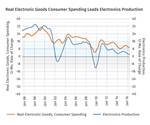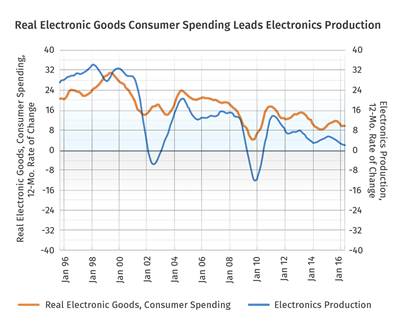Appliance Growth Slowing
Current growth rate in production is strong, but the dip in housing permits could change things.
Since May 2012, appliance production has grown in all but about 12 months. In our last update in October, we noted the leading indicators were pointing in a positive direction for the industry.
But the indicators have turned in the last six months. Here’s what’s going on:
Real 10-Yr Treasury Rate. The real (inflation-adjusted) 10-yr U.S. Treasury bond interest rate was 0.92% in February, which was a slight decline from last month. This was the first month below 1% since November, and it was the lowest rate since October. The nominal rate currently was 242 basis points (2.42%), which was virtually unchanged from last month. But the rate of inflation rose to its fastest rate since February 2012. In February 2017, inflation was above 2.5% for the second straight month. Increasing inflation is limiting the rise in the real 10-yr Treasury rate even though the nominal rate has increased (the real rate is the nominal rate minus inflation). The year-over-year change in the real rate increased to -53 basis points (-0.53%). That was the fourth straight month of an increase and the highest it has been since May 2016.
The interest rate is an extremely important indicator for the appliance industry because of its significant impact on the housing market. Generally, a lower rate either encourages refinancing of mortgages, providing cash for home improvements, or it makes the monthly payment of a new mortgage lower, which tends to spur activity in the market. Either tends to lead to purchases of new appliances.
Housing Permits. There were 84,500 housing permits filed in February 2017. This was the lowest level for permits since January 2016. Compared with one year ago, housing permits were unchanged, which was the second time in three months that permits did not grow. The annual rate of growth decelerated to 0.3%, which was the slowest since October 2011.
Housing permits tend to lag changes in the real 10-yr Treasury rate by about one year. Since October 2016, the change in the interest rate has been moving in a negative direction for housing permits. Therefore, I expect the annual change in housing permits to contract at some point in 2017.
Appliance Industrial Production. Despite the extended period of growth since May 2012, the actual level of appliance production is still at the bottom of the production levels from 1994 to 2007. That shows what a toll the industry took as a result of the popping of the housing bubble about 10 years ago.
In February, appliance production was up 2.4% from where it was one year prior. That was the slowest rate of month-over-month growth since March 2016. The rate of growth has slowed significantly since last fall. As a result, the annual rate of change in appliance production (see graph) grew at a slightly slower rate in February. While the current growth rate is quite strong, I expect the growth in appliance production to slow throughout 2017.
ABOUT THE AUTHOR: Steven Kline Jr. is part of the fourth-generation ownership team of Cincinnati-based , which is the publisher of Plastics Technology. He is currently the company’s director of market intelligence. Contact: (513) 527-8800 email: skline2@gardnerweb.com; blog: gardnerweb.com/economics/blog
Related Content
Performance Nylon 6 and 66 Resins with High PCR/PIR Content
Syensqo has further extended its Omnix Echo portfolio of circular engineering resins with five new additions.
Read MoreUltralight PET Preform Design
The Factor 101 design created by KHS and Husky uses just 5.89 g of material to hold 591 mL of product — equivalent to a 20-ounce water bottle.
Read MoreHigh-Jetness Carbon Black for Engineered Plastics
Orion’s new Printex chroma 500 Beads are well suited for applications such as injection molded automotive parts and household appliances.
Read MoreBraskem Selected to Negotiate Federal Funding Award to Expand UHMWPE
By driving innovation for Braskem’s ‘Utec’ UHMWPE, the project would strengthen the lithium-ion battery value chain in the U.S.
Read MoreRead Next
Growth in Electronics Production to Remain Weak
Spending on electronics has been growing, but the pace is probably not sustainable.
Read MoreMaking the Circular Economy a Reality
Driven by brand owner demands and new worldwide legislation, the entire supply chain is working toward the shift to circularity, with some evidence the circular economy has already begun.
Read MoreFor PLASTICS' CEO Seaholm, NPE to Shine Light on Sustainability Successes
With advocacy, communication and sustainability as three main pillars, Seaholm leads a trade association to NPE that ‘is more active today than we have ever been.’
Read More.JPG;width=70;height=70;mode=crop)









